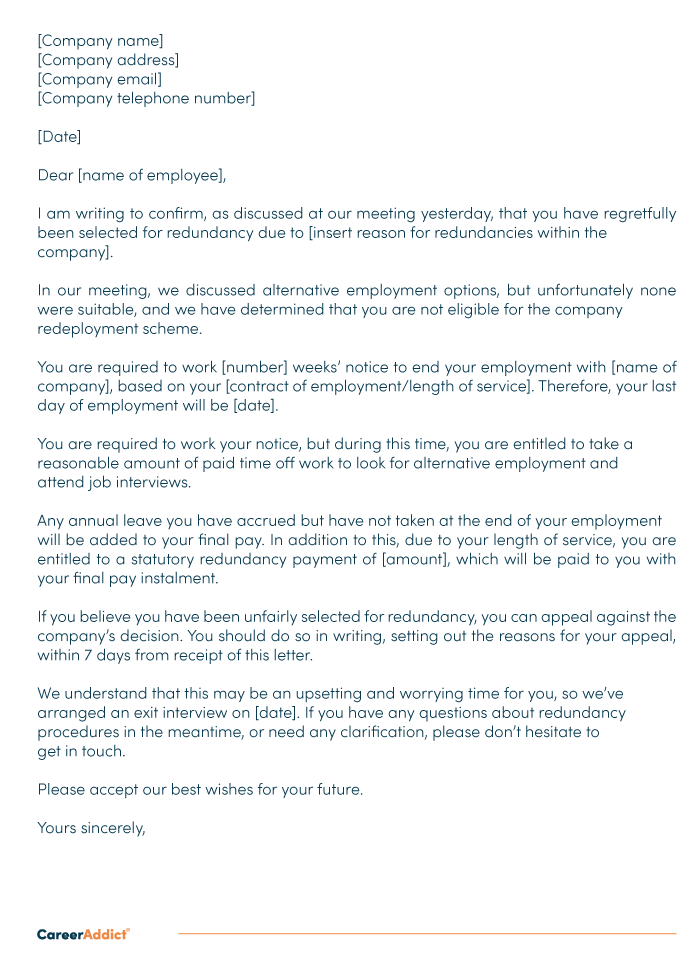Small Business Closing Employee Rights UK: Guaranteeing Fair Redundancy Pay
Small Business Closing Employee Rights UK: Guaranteeing Fair Redundancy Pay
Blog Article
Checking Out the Interaction In Between Firm Redundancy and Business Versatility for Future Development
In the dynamic landscape of today's company globe, the elaborate partnership between company redundancy and business versatility arises as an important element for continual development and success. Firms frequently deal with the challenge of striking a delicate balance between maintaining a level of redundancy to reduce risks and promoting flexibility to respond quickly to the ever-evolving market demands.
Importance of Company Redundancy
Company redundancy is a crucial component that improves organizational durability and reduces operational dangers. By incorporating redundancy procedures within the business structure, business can better withstand unanticipated interruptions and variations in the company atmosphere. Redundancy offers as a critical buffer, enabling business to adapt and react successfully to unforeseen obstacles without endangering crucial procedures.
One key aspect of the importance of company redundancy is its duty in guaranteeing continuity throughout times of dilemma. When confronted with unexpected adjustments or emergency situations, redundant systems, sources, or personnel can action in to keep essential features and stop extensive disruptions. This continuity not only safeguards the business's reputation and customer count on yet likewise decreases monetary losses and functional downtime.

Strategies for Organizational Flexibility

An additional vital approach is spending in modern technology and facilities that can sustain flexibility and scalability. Implementing digital tools, automation, and information analytics can enhance procedures, enhance effectiveness, and offer important understandings for notified decision-making. In addition, producing adaptable business structures that permit for fast adjustments to market dynamics and client requirements is important for remaining competitive in a rapidly progressing atmosphere. By proactively identifying potential disruptions and possibilities, organizations can proactively flourish and adjust in an ever-changing organization landscape.
Harmonizing Redundancy and Adaptability
Attaining a harmonious balance in between operational redundancy and business adaptability is paramount in navigating the intricacies of a dynamic service setting. Redundancy within a business supplies a security internet, making certain continuity and stability in operations. However, an excess of redundancy can lead to inefficiencies and impede flexibility to altering market problems. On the various other hand, business versatility permits companies to react without delay to outside disruptions and seize new chances. Striking the appropriate equilibrium in between redundancy and versatility is a delicate process that calls for a deep understanding click now of the organization's goals, industry characteristics, and threat resistance.
To achieve this balance, firms need to this link perform regular evaluations of their procedures to recognize areas where redundancy is required for danger reduction and where flexibility can drive technology and development. Carrying out adaptable structures, promoting a culture of continuous learning and improvement, and encouraging open interaction throughout all levels of the organization are key methods to integrate redundancy and versatility successfully. By lining up these two important aspects, companies can position themselves for lasting development and success in an ever-changing business landscape.
Study on Adjustment Success
In examining instances of effective business adaptation, it comes to be noticeable that the interplay in between operational redundancy and adaptability is a specifying aspect in forming resilient organizations. One engaging situation research study is that of Netflix. At first a DVD rental service, Netflix showed impressive adaptability by transitioning into a streaming platform when digitalization interrupted the industry. By purposefully buying innovation and web content production, Netflix not only thrived but endured in a swiftly progressing market. One more standout example is Amazon. Starting as an online book shop, Amazon continually adjusted its business version, expanding into varied industries such as cloud computing and expert system. This adaptability allowed Amazon to stay in advance of competitors and fulfill altering customer needs. Last but not least, Adobe supplies a noteworthy illustration of successful adaptation. The firm shifted from marketing software program licenses to a subscription-based design, ensuring persisting income streams and improved customer engagement. These study highlight the this hyperlink importance of operational redundancy combined with organizational flexibility in fostering long-lasting growth and competition.
Building Strength for Future Development
Structure strength for future growth requires a strategic positioning of functional procedures with market dynamics and arising fads. Companies should adjust to altering settings by fostering a culture of flexibility, advancement, and constant improvement. Resilience entails not just getting better from problems however additionally proactively preparing for future challenges. One key facet of structure durability is investing in durable threat management approaches to alleviate potential interruptions. This includes circumstance preparation, branching out supply chains, and creating contingency prepare for different contingencies (who pays redundancy money).
Additionally, promoting solid connections with stakeholders, such as customers, workers, providers, and the area, is vital for maintaining and weathering uncertainties depend on and assistance throughout turbulent times. Reliable interaction and transparency play a vital function in structure resilience, as they assist facilitate and align assumptions collaboration in browsing uncertainties.
Furthermore, organizations need to prioritize knowing and development campaigns to upskill workers and outfit them with the needed tools to adjust to altering circumstances. By purchasing their workforce, firms can improve their adaptability and dexterity, eventually strengthening their resilience for sustainable future growth.
Verdict

In the dynamic landscape of today's business globe, the intricate partnership between firm redundancy and business flexibility arises as a critical element for sustained growth and success. Firms commonly deal with the obstacle of striking a delicate balance in between keeping a level of redundancy to alleviate threats and fostering versatility to respond promptly to the ever-evolving market needs.To achieve this balance, business need to perform regular assessments of their operations to identify locations where redundancy is required for threat mitigation and where versatility can drive technology and growth.In conclusion, the interplay between firm redundancy and business adaptability is critical for future development. Building durability via a mix of redundancy and flexibility will certainly guarantee that companies are prepared for the obstacles of the future.
Report this page